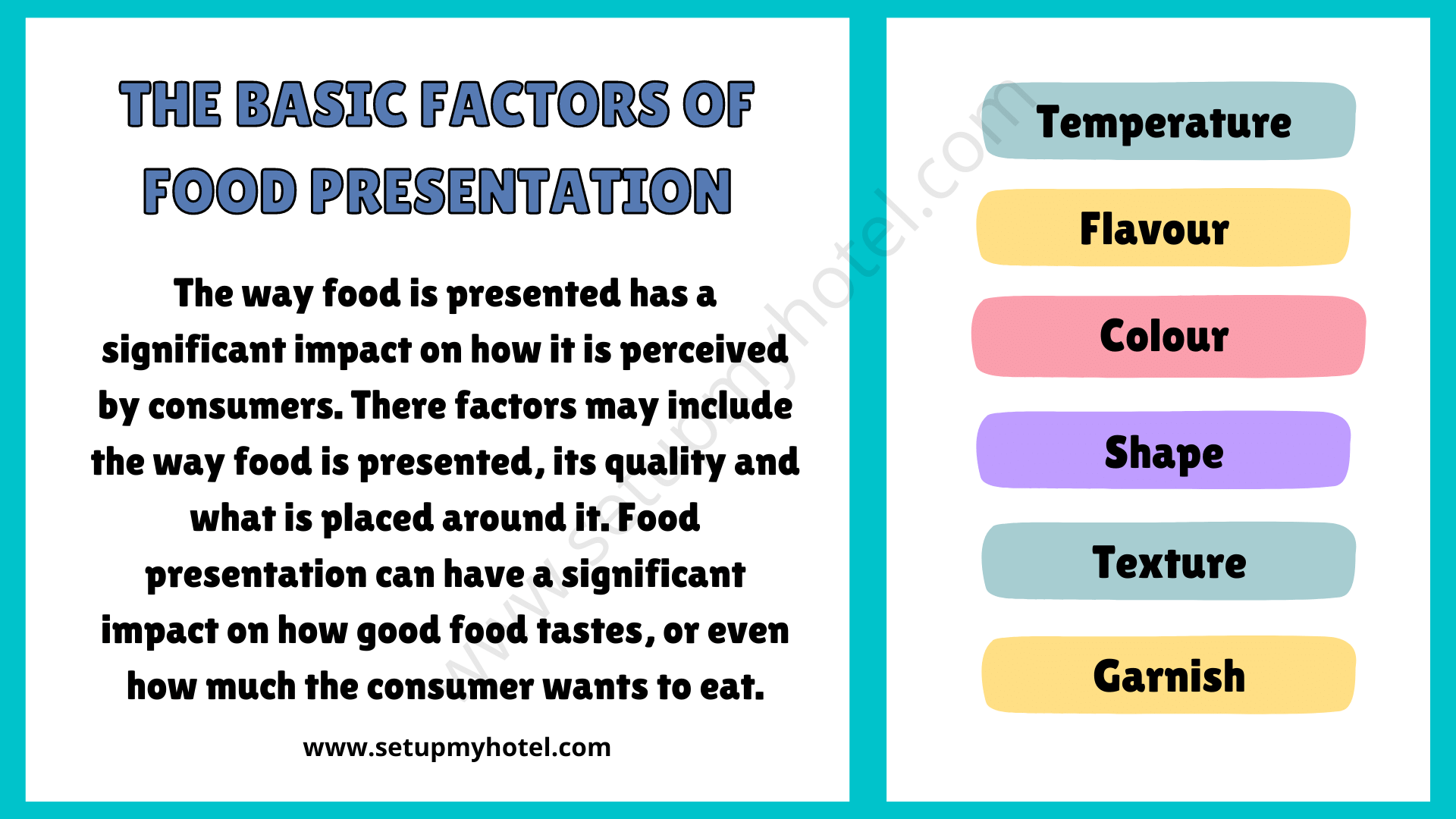Basic Factors Of Food Presentation in the Hotel Industry
The way food is presented has a significant impact on how it is perceived by consumers. These factors may include the way food is presented, its quality, and what is placed around it. Food presentation can have a significant impact on how good food tastes, or even how much the consumer wants to eat.
1. Temperature
Good presentation of food means nothing if the food is not at the correct serving temperature. To ensure the quality of hot food, serve it on hot plates and platters. All the food should be at the correct temperature before placement on the plate or platter. Hot food should be covered with warm plate covers, to retain heat. Hot food must be served to the customer immediately.
Temperature is the most basic component in food presentation. HOT FOOD SHOULD BE SERVED HOT! FOOD SHOULD BE SERVED ICE COLD! Food temperature synchronization demands careful planning and execution. We can now discuss the various aspects of presentation while keeping these primary criteria in mind.
2. Flavor
A plate of food is intended to be eaten. This means everything from the plate. When the guest begins to eat, they do not eat the meat on the plate first, then the vegetable, and then the potato. They take bites of each. At any point, the mouth of the guest contains the flavor of every food presented on the plate. If the combined flavors of these items are not pleasing, then the mouth is not happy.
Knowing how to place food on the plate will help you create a well-balanced dining experience. Always remember that generally, rich dishes are served with mild food; sweet meals are served with hot, and sweet meals with sour. Your goal is to produce a flavourful, not overwhelming, trace experience for the prospect. To add so much something special to a dish that it would overwhelm the palate is done rarely.
Remember that it is the flavor that makes food enjoyable. However, the flavor is not always obvious to the eye. To create eye appeal in presentation requires you to think about other things.
3. Color
In presenting food, hot or cold, don’t forget that multiple colors are more appealing to the eye. However, too many colors can create the effect of confusion. The colors used are natural in food and beverage presentation. artificial or non-food colors should never be used. The color should not be simply placed on plates or platters; it should be derived from something with a purpose. The color must not merely be put on plates or platters. You should aim for significance; consider the function of the color.
The use of fruits and vegetables with meat dishes will always improve the color of the presentation but should be appropriate for the dish. The goal is to create a plate with eye appeal. However, the color on the plate should be part of what is to be eaten.
4. Shapes
The possibility of shapes is limited only by your imagination. What you create must be produced for many people. You can carve miniature leaves from zucchini that will look great and add color to the plate.
There are a great many possible cuts of vegetables and fruits which can be done without huge effort. Make good use of the simple cuts. Use a variety of long thin cuts, rounds, triangles, half rounds, slices, squares, and rectangles. These will improve your presentation greatly, without great effort.
Choose foods whose natural shapes complement each other. A poached baby apple with a spiced fruit chutney served with a natural broiled chicken breast and asparagus spears will result in a plate with balanced flavor, color, and shape. Little effort is required. The shapes were created by nature.
5. Texture
Texture in food presentation takes two forms. One is the way food feels in the mouth: Soft, firm, crunchy. The second form is the exterior appearance of an item. As with flavor, color, and shape, variety is the key to using texture.
Food presented as a group must be balanced in texture. If it is together on a plate, there should be soft, firm, and preferably crunchy food. This will give the balance which satisfies the urge to bite into something.
This can be done by using a variety of preparation methods as well as foods. With a nice crisp fried chicken, a mashed potato is fine. A poached chicken breast would go much better with julienne carrots and snow peas. A variety of textures, both physical and visual, should be present on each plate.
1. Physical
- Smooth
- Coarse
- Solid
2. Visual
- Pureed
- Speckled
- Patchy
6. Garnish
Food presentation is often referred to as GARNITURE. This is defined as the process of GARNISH. The term garnish originated from the French term decorer which means “to adorn or to furnish.” In English, the term is more generalized. The term GARNI is also used to mean garnish. History shows that these terms have been used for a variety of preparations and dishes over the centuries.
Many of these classical garnishes are used in today’s kitchens. They act as a base for developing new and different presentations. Keeping in mind the basic guidelines for presentation, use the classical garnishes to begin your exploration of garniture.
Conclusion: By understanding and taking into account these basic factors of food presentation, you can create a more appetizing dish that will leave your guests impressed.











